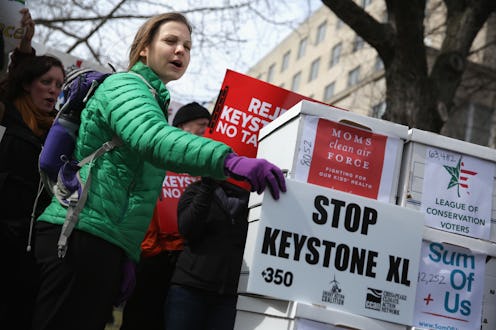News
The 7 Things You Need To Know About Keystone XL
In a surprising move last week, Senate Majority Leader Harry Reid announced that the Senate would vote on the Keystone XL pipeline, a proposed section of pipe that would carry crude oil from Canada all the way down to Texas. It was a surprising move, that was, until the vote was cancelled last Wednesday due to disagreement over how the Senate vote would be conducted. Now, the decision about the Keystone XL pipeline remains at a standstill. Again.
Republicans love Keystone XL, touting it as a big job creator. Environmentalists hate it, arguing that it would substantially increase greenhouse gases. Nobody is quite sure how President Obama feels, considering he's delayed making a decision on the pipeline's construction for just about as long as physically possible.
Here are seven questions you need to know the answers to before you decide which side you're on.
What Is the pipeline's purpose again?
The purpose of Keystone is to carry oil from the tar sands in Alberta, Canada all the way down to Houston, Texas. But most of the pipe needed to accomplish this has already been constructed: Currently, the Keystone pipeline stretches south from Alberta to Cushing, Oklahoma, with another segment stretching east from Steele City, Nebraska to Patoka, Illinois. Another segment that goes from Cushing down to Texas is currently under construction.
So why is that controversial?
The object of debate is a proposed extension to the pipeline — the Keystone XL — which would stretch from Alberta down to Nebraska through a much shorter route than the existing pipeline. In general terms, this would result in faster shipment of tar sands oil to the U.S., more integration of tar sands oil into the U.S. oil economy, and some amount of jobs being created in the U.S. Most of the controversy surrounds the nature of the pipeline’s economic and environmental impact.
but Would it actually be that bad for the environment?
The Keystone pipeline carries a couple of types of oil, but the primary goal of building the extension is to increase the exports of diluted bitumen, or tar sands oil. The most pertinent fact here is that tar sands oil emits around 17 percent more greenhouse gases than the average barrel of crude oil. That’s according to the State Department, which recently issued a report on the pipeline’s environmental impact.
which side does it seem like the government is on?
The State Department — which has to approve the pipeline, since it would cross international borders — doesn’t reject the idea that tar sands oils are worse for the environment. However, it nevertheless determined that Keystone XL wouldn’t actually have a significant environmental impact. That’s because, according to State, the tar sands oils up in Alberta will ultimately be extracted regardless of whether Keystone XL is built. Keystone XL simply allows them to be transported faster.
That said, the report itself might be biased: As Mother Jones reported, many of the contractors hired by the State Department to conduct the review were ex-employees of TransCanada, the company that’s trying to build the pipeline. As a result, the State Department’s Inspector General launched an investigation into the compilation of the report, although it ultimately determined that there was no conflict of interest.
The EPA — which probably has a bit more expertise in environmental manners than the State Department — took issue with how State's report was compiled.
what would the immediate effects of the pipeline be?
Despite the State Department’s conclusion, Keystone XL would still have a huge environmental impact in the short run, sending 181 million metric tons of greenhouses gases into the atmosphere every year. That’s the equivalent of 37 million extra cars on the road. Such an impact would, in turn, make it impossible for Canada to reach its stated goal of reducing its greenhouse emissions by 17 percent by 2020.
ok, but would it create a ton of jobs?
One of the main arguments for building Keystone XL is that it would create jobs. That’s technically true. It wouldn’t, however, create very many jobs. During its two-year construction period, it will either produce 5,000 American jobs (the State Department's estimate) or 10,000 (TransCanada's estimate). After that, however, Keystone XL would employ only employ around 35 people. Not 35 additional employees per year, but a grand total of 35 full-time workers.
are there any other risks to the pipeline?
There’s a distinct concern with the pipeline that’s separate from the general environmental issues. As originally proposed, Keystone XL would pass through Nebraska’s Ogallala Aquifer, a major freshwater supplier for the Great Plains. If that section of the pipeline ever suffered a break or malfunction, the consequences would be monumental, as nearly one third of America’s drinking water could potentially be contaminated.
Keystone subsequently revised the route in order to circumvent the aquifer, but according to review conducted by the state, that reduced but didn’t eliminate the risk of a catastrophic spill.
Those are the facts. The opinion is all you.
